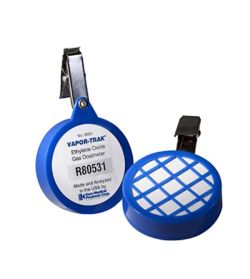Preventing EtO Exposure: Possible Solutions
The list below includes ideas you may be able to use to prevent or mitigate EtO exposures.
- Substitute other cold sterilants for EtO.
- Use proper ventilation with EtO gas.
- Reduce exposure to EtO during the sterilization process.
- Do not occupy the sterilizer loading and mechanical rooms while operating the sterilizer unit.
- Operators should crack the door no more than two inches and allow the load to "off-gas" before moving to transfer carts. A ventilated exhaust hood should be installed above the sterilizer door.
- Operators should avoid close contact with newly sterilized unaerated loads.
- Vent ethylene oxide through a dedicated, non-recycled ventilation system.
- To detect inadequate ventilation and cause an automatic shutdown, have machine alarms in place. Air pressure in laboratories and isolation rooms should be negative so that contaminated air is drawn through the exhaust vents rather than circulating throughout the building.
- Use appropriate PPE when changing cylinders, including a butyl apron, gloves, and a canister respirator.
- Use EtO detector systems and room monitors to signal any leakage of gas and passive dosimeters for personal exposure monitoring.
- Use specialized gas-line connections to minimize EtO leakage during use and change out of EtO cylinders.
- Conduct periodic personal monitoring, as well as monitoring for leaks at gas-line connectors.
- Keep a written log for any detected leak and any service done on an ethylene oxide chamber. Replace sterilizer/aerator door gaskets, valves, and fittings when necessary.
Knowledge Check Choose the best answer for the question.
1-8. Operators should crack the door no more than ______ and allow the load to "off-gas" before moving to transfer carts.
You forgot to answer the question!

